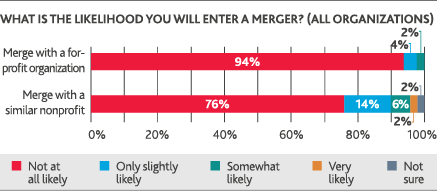Strategic Planning
Operating Reserves
When organizations encounter funding disruptions or lose a major donor, a healthy supply of operating reserves (liquid, unrestricted net assets) is a critical fiscal safety net to keep programs up and running. Liquidity is not a one-size-fits-all metric: The “right” amount of operating reserves varies according to organization size, sector, and scope. With that in mind, establishing at least six months of operating reserves is a prudent target for the sector overall.
About half of organizations surveyed (49 percent) surpass that 6-month target, while the remaining 51 percent fall short.
Just six percent of nonprofits have no operating reserves.
Midrange nonprofits have more robust operating reserves than their larger counterparts. Half of midrange nonprofits have more than 12 months of liquid, unrestricted net assets, and another 10 percent have between seven and 12 months. While midrange organizations have a stronger supply of operating reserves, this does not necessarily signify that those nonprofits have lower operating costs. Instead, it could be an indication that midrange organizations are less likely to tie up their reserves in illiquid assets.

While our findings demonstrate that many nonprofits may have gaps in their fiscal safety nets, few nonprofit leaders consider maintaining adequate liquidity to be a significant challenge for their organization in the next year. About one-third (34 percent) say maintaining adequate liquidity poses no challenge and another 40 percent rank it as a low-level challenge.
Midrange organizations are the least concerned: 90 percent say it is a low-level challenge or not a challenge. Upper midrange and large organizations are more likely to consider it a high or moderate challenge, ranked by 33 percent and 25 percent, respectively.
Future Plans: Changes to Program Offerings
Forty-two percent of nonprofits report that the inability to meet demand for their services will be a high- or moderate-level challenge in the next year, while 21 percent say it is not a challenge.

When asked how program offerings might evolve to meet the needs of their constituents, nonprofits are more likely to expand their offerings than constrict services. Forty-seven percent of nonprofits say it is somewhat likely they will introduce new programs without eliminating others, while 15 percent consider it to be a very likely next step.
Organizations are also looking for opportunities to refine their offerings: 40 percent say it is somewhat or very likely they will eliminate some current programs and introduce new ones. Across the board, few nonprofits plan to downsize their services and eliminate some current programs without adding others. Just 18 percent select that as a somewhat likely or very likely occurrence in the next two years.

Managing Growth Perhaps with this outlook for potential program expansion in mind, 40 percent of respondents indicate managing growth is a high or moderate challenge for nonprofit boards.
.png)
Future Plans: Outlook for Mergers and Strategic Partnerships
Are mergers or strategic partnerships on the near-term horizon for nonprofits?
Strategic Partnerships
When it comes to collaboration, nonprofits are far more likely to enter strategic partnerships with similar nonprofits than with for-profit companies. Thirty-six percent of nonprofits indicate it is very likely (11 percent) or somewhat likely (25 percent) they will enter a strategic partnership with a similar nonprofit in the next two years.
Conversely, 60 percent of nonprofits say it is not at all likely they will partner with a for-profit in the same timeframe.

Upper midrange organizations appear the most likely to partner with for-profits: 23 percent say it is either very likely or somewhat likely.
Mergers
For better or for worse, mergers are largely not on nonprofits’ radars. A little more than three-quarters (76 percent) say merging with a similar nonprofit is not at all likely. Not surprisingly, the chances of mergers with for-profits is even more slim. An overwhelming majority (94 percent) agree that merging with a for-profit is not at all likely.
Large and upper-midrange nonprofits are more likely to consider merging with another nonprofit organization than their midrange counterparts who almost unanimously say it’s not in the cards.


SHARE